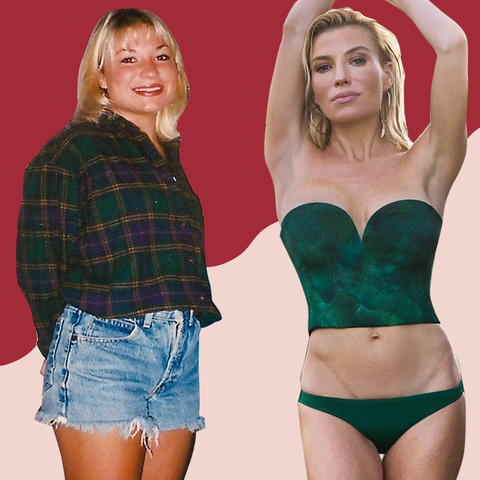

My mom was a professional ballerina, which meant I was in her studio daily growing up, and developed a love for dancing early on. So when I accepted a dance scholarship to college, no one was surprised that I had decided to turn the art of movement into my life’s work.
But while I’d inherited my mother’s passion and talent, there was one thing I definitely did not inherit: Her dancer’s body genetics. Even though I was eating well and exercising every day, for hours, I was putting on weight quickly.
By age 20, I was significantly overweight.
View this post on Instagram
A post shared by Tracy Anderson (@tracyandersonmethod) on
In the professional dance world, you see variation in height, but you rarely see any differences in weight. My teachers made it quite clear that, even though I was talented, there was no room for a voluptuous ballerina. I needed to do something, fast.
Unfortunately there weren’t any other solutions offered for my “problem” other than what I saw other people in my program doing—under-eating, over-exercising, and taking drugs.
“At 43 years old, I feel far more in control around food, and more balanced in my body.”
Instead of falling into the trap of eating disorders or substance abuse, I decided to take the opposite path—eat whatever I wanted. I figured however my body ended up was just how it was supposed to be. I really bought into the mentality of “This is just who I am and it’s unhealthy to try to be someone I’m not by dieting.”
It wasn’t until I gained 60 pounds that I realized neither of those extremes is healthy.
I was 22 years old, and I’d just given birth to my son, when I finally realized that I needed to start from scratch when it came to taking care of my health.
At this crucial moment, my husband at the time (NBA player Eric Anderson) was suffering from a sports injury. When I met the doctor who was helping him, something hit me: This doctor had done so much research on the best ways to train muscles and rehab injuries, but he didn’t know how to make a fitness program that would put his theories into practice. From there, I was inspired to use my dance training to extend that science, and develop what is now The Tracy Anderson Method.
View this post on Instagram
A post shared by Tracy Anderson (@tracyandersonmethod) on
I read everything I could get my hands on and studied with many different professionals, built a foundation in Pilates, and later went on to conduct my own fitness studies. I began to realize just how unique each of us are, and how wrong my former approaches to “health” had been. As my mind changed, so did my body.
My fitness journey, which is now going on 20+ years, was never just about weight loss.
Sure, I wanted to lose my baby weight—but what I really wanted was to be healthy, strong, and balanced in a way I could sustain my whole life. So, it’s been my mission to make my program something that can unite the inner and outer selves, bringing balance physically—through targeted strength workouts and cardio—but also spiritually, mentally, and emotionally.
“My own transformation has given me a lot of empathy for other women.”
These days. I’m a different person. I don’t hate my body or try to punish it with grueling workouts or diets. (Pro tip: Those tactics may work in the short term, but they’ll backfire in the long run!) At 43 years old, I feel far more in control around food, and more balanced in my body. And I’m confident that as I age, I’ll maintain that balance, because I’m consistent.
My fitness schedule consists of doing one of my “strategic muscle exhaustion” workouts every single day, for an hour, or an hour-and-a-half, max. Every week, I come up with a new program, and they’re designed to fit together like puzzle pieces, constantly creating balance in the body.
View this post on Instagram
A post shared by Tracy Anderson (@tracyandersonmethod) on
That said, though, it’s important to make exercise fit into your life, not make your life centered around your workouts. If I’m coming up on my period and PMSing hard, I’ll cut myself some slack and take it easy. Or if I’ve got to do stuff for my kids, I’ll take a day off and not worry about it. I can have this positive, relaxed attitude because I’ve created workouts that I love to do, not ones I dread, so I know I’ll want to get back to them as soon as I can.
I try to keep a really balanced approach to my diet, too.
Other than avoiding meat from four-legged animals (I have an actual meat allergy, brought on by a tick bite), I try not to cut anything out of my diet. I focus on eating organic, whole foods as much as possible.



But, if I want a treat, I’m going to have a treat. And none of this “don’t keep bad foods in your house” nonsense. Foods aren’t bad or good, and you’re not bad for wanting to eat. I think demonizing a certain food only makes you want it more. But if you know that it’s always available, it makes your brain realize it’s not an emergency, making you less likely to binge.
I try to incorporate all of these concepts into my online streaming service, The Tracy Anderson Online Studio. I’m well known for my work with celebrities, but my strategic program works for everyone. It’s about building your best body—one that’s strong, beautiful, and resilient—not about looking like some celebrity.
View this post on Instagram
A post shared by Tracy Anderson (@tracyandersonmethod) on
Looking back at old pictures is very poignant for me now. My own transformation has given me a lot of empathy for other women who have to work hard for their bodies and don’t just get it “naturally.” And if I can do this, anyone can! My experiences have taught me that our lives, and our bodies, are so much more than genetics—they’re what we make them, and you can make yours an amazing one.
For more information on Tracy Anderson or the TAM, check out her site or follow her on Instagram. Look for her new app, new book and more in 2019!
Need more inspo? It’sTransformations Week on WomensHealthMag.com! For more amazing beauty, fitness, and weight loss transformations, check out the rest of our Transformations Week collection.
Source: Read Full Article